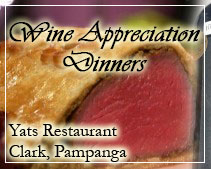This delicacy also allows Chardonnay to absorb the influences of both vinification technique and appellation of origin.
Rich is the word that best both describes Chardonnay and explains its popularity. Its aroma is distinct, yet delicate, difficult to characterize, easier to recognize. It often smells like apples, lemons, peaches or tropical fruits. Its delicacy is such that even a small percentage of another varietal blended into a Chardonnay will often completely dominate its aroma and flavor. Oak commonly takes over Chardonnay if the wine is fermented or aged in new barrels or for too long in seasoned ones.
This delicacy also allows Chardonnay to absorb the influences of both vinification technique and appellation of origin. In the Chablis region of France, it is the only grape permitted and it renders a “crisp, flinty” wine. In the Meursault appellation, chardonnay takes on a lush, ripe, “fleshy”, “buttery” quality. Even in quality sparkling wines and French Champagne, it is the major varietal used. California Chardonnay is every bit as variable and possibly even more exciting because of the effusive varietal quality it develops there. In spite of this variety in style, Chardonnay is unmistakable in the mouth because of its impeccable sugar/acid balance, its full body, and its easy smoothness.
Researchers at the University of California at Davis used DNA profiling in 1999 to prove that Chardonnay originated as a cross of an obscure, ancient, and nearly extinct variety called gouais blanc with a member of the “pinot” family, quite likely pinot noir (although ampelographic research has not yet been able to pinpoint this).
Vineyards in France are commonly planted with an intermingling of chardonnay and pinot blanc vines, so that “pinot” has often been attached to chardonnay, incorrectly. In spite of its heritage, Chardonnay is not considered a member of the “pinot” grape family (pinot noir, pinot blanc, pinot gris, etc.). Chardonnay leaf (photograph).California has achieved real success growing chardonnay and popularity of its wine. It has also been a successful grape in Australia, where it also is sometimes misnamed “pinot chardonnay”.
Unfortunately, chardonnay vines are shy-bearing and susceptible to a myriad of maladies. Chardonnay berries are relatively small, thin-skinned, fragile, and oxidize easily. This makes chardonnay somewhat more sensitive to winemaking techniques and more difficult to handle from harvest to bottling than most other grape types.
Different wine making techniques also produce wide variances in the Chardonnay flavor profile. Such techniques as barrel fermentation, proportion of new to old cooperage, lees stirring, and partial, complete, or prevention of malolactic fermentation generate controversy and lively discussion among winemakers.
Chardonnay’s intrinsic blank canvas quality also allows its flavors to be dramatically affected by differences in soil, climate, and vineyard practices. Not uncommon among wine grapes, the chardonnay vine also has a tendency to mutate and research has identified over 400 clonal variants. Each clone has chardonnay family traits, but displays individually specific tendencies in such characteristics as length of ripening cycle, crop load, berry and cluster size, acid retention, etc., therefore producing wines with various flavor differences.
The widespread popularity of varietally-labeled Chardonnay wines spurred many new California plantings in the early 1970s. The most commonly planted clone was the “Wente” clone (UCD 2A) and, later, clone 108, isolated at UC Davis from vines grown in Carneros. Due to this grape’s blank canvas nature and the proliferation of new vineyard sources using essentially only two clones, regional variations in Chardonnay wines became more apparent than perhaps in any other varietal wine in the late 1970s and early 1980s.
In the 1990s, California vintners began paying much more attention to matching, not only varieties but also clones, to specific microclimates and vineyard sites. Many new vineyards and re-plantings since then, especially in cooler regions, have propogated the “Dijon” clones (particularly 75, 76, 78, 95 and 96), the “Espiguette” clone (352) or, in fewer locations, “Champagne” clones.
The most common (but not exclusive) smell and/or flavor elements found in chardonnay-based wines include:
| Chardonnay Smell and/or Flavor Elements | |
| Varietal Aromas/Flavors: | Processing Bouquets/Flavors: |
| Stone Fruits: apple, pear, peach, apricot | Malolactic: butter, cream, hazelnut |
| Citric Fruits: lemon, lime, orange, tangerine | Oak (light): vanilla, sweet wood, coconut |
| Tropical Fruits: pineapple, banana, mango, guava, kiwi | Oak (heavy): oak, smoke, toast, lees, yeast |
| Floral: acacia, hawthorn | Terroir: flint, mineral, mint |
Two popular trends keep California Chardonnays from reaching the elevel of respect given to those from France: one is to satisfy consumer lust for any wine labeled “Chardonnay” with bland but inexpensive “cookie-cutter” wines; the other is to overwhelm any varietal personality or microclimatic subtlety with lavish amounts of oak barrel fermentation and aging.
Although California appellations have a shorter history than those of France, distinct regional characteristics emerge with the passage of each vintage. Eventually, proper site and clone matching and judicious production techniques may allow California AVAs to consistently show Chardonnay with distinct regional flavors.
The nominees for Best Supporting Appellation in a California Chardonnay are: Russian River Valley, shared by Sonoma and Mendocino Counties (apples, pears & peaches); Carneros, shared by Sonoma and Napa Counties (flinty); Monterey County (citric, lemony); Santa Maria Valley, Santa Barbara County (pineapple, tropical); Edna Valley, San Luis Obispo County (apricot, fleshy).
Challenges and difficulties in growing Chardonnay and higher production costs from barrel treatments, combined with increasing popular demand over the past decades, contribute to making chardonnay-based wines one of the most expensive on the shelf or winelist.
Source: http://www.winepros.org/wine101/grape_profiles/chardonnay.htm









